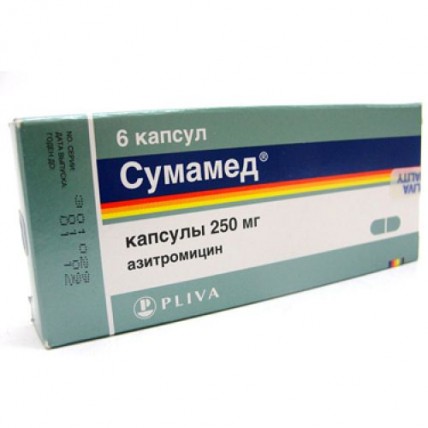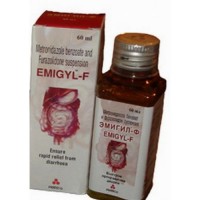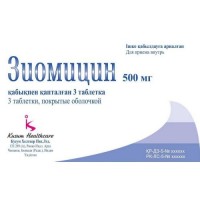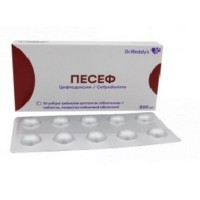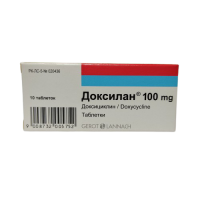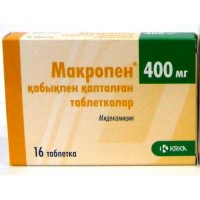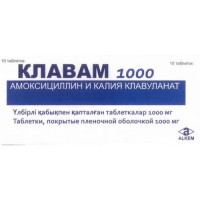Sumamed® 250 mg (6 capsules)
- $29.20
Structure
One capsule contains the active ingredient - azithromycin dihydrate, 250 mg
Indications for use
- pharyngitis, tonsillitis, sinusitis, otitis media
- acute and chronic bronchitis, interstitial and alveolar pneumonia
- chronic erythema migrans - the initial stage of Lyme disease, erysipelas, impetigo, secondary pyodermatosis
- diseases of the stomach and duodenum associated with Helicobacter pylori
- gonorrheal and non-gonorrheal urethritis and / or cervicitis
Method of administration and dosage
Sumamed capsules 250 mg are taken once a day 1 hour before meals or 2 hours after meals.
For infections of the upper and lower respiratory tract, infections of the skin and soft tissues, 500 mg / day is prescribed for 3 days (course dose - 1.5 mg).
For uncomplicated urethritis and / or cervicitis, 1 g is prescribed once (4 capsules of 250 mg).
In Lyme disease (borelliosis), for the treatment of the initial stage (erythema migrans), 1 g (4 capsules of 250 mg) are prescribed on the first day and 500 mg daily from the 2nd to the 5th day (course dose - 3 g).
For diseases of the stomach and duodenum associated with Helicobacter pylori, Sumamed is prescribed 1 g (4 capsules of 250 mg) per day for 3 days as part of combination therapy.
In case of missing one dose of the drug, the missed dose should be taken as early as possible, and the subsequent ones should be taken at intervals of 24 hours. The elderly and patients with impaired renal function do not need to change the dosage.
For the treatment of children, it is necessary to use the children's forms of Sumamed: Sumamed 125 mg and Sumamed 100 mg / 5 ml, Sumamed Forte 200 mg / 5 ml.
Side effects
Often (> 1/100, <1/10)
- nausea, vomiting, diarrhea, abdominal pain
Not often (> 1/1000, <1/100)
- loose stools, flatulence, indigestion, loss of appetite
Rarely (> 1/1000, <1/100)
- headache, dizziness, drowsiness, convulsions, dysgeusia
- thromocytopenia
- aggressiveness, agitation, anxiety, nervousness, insomnia
- paresthesia and asthenia
- hearing impairment, deafness and tinnitus
- tachycardia, arrhythmia with ventricular tachycardia, prolongation of the QT interval
- discoloration of the tongue, constipation, pseudomembranous colitis
- transient rise in the level of liver aminotransferases, bilirubin, cholestatic jaundice, hepatitis
- hypersensitivity reactions (redness, skin rash, itching, urticaria,
angioneurotic edema, photosensitivity), erythema multiforme, Steven-Johnson syndrome and toxic epidermal necrolysis,
- arthralgia
Very rare (> 1/10000, <1/1000)
- interstitial nephritis, acute renal failure
- fatigue, convulsions
- change in taste and smell
- arthralgia
- vaginitis, candidiasis, superinfection
- anaphylactic shock including edema (in rare cases leading to death)
Contraindications
- known hypersensitivity to macrolide antibiotics
- severe violations of liver and kidney function
- children under 18 years of age (due to the presence of a dye)
- the first trimester of pregnancy and lactation
Drug interactions
Antacids significantly reduce the absorption of Sumamed, so the drug should be taken one hour before or two hours after taking these drugs. Macrolide antibiotics interact with cyclosporine, astemizole, triazolam, midazolam, or alfentanil. It is recommended to conduct close monitoring while taking these drugs.
Azithromycin does not affect cytochrome P-450 and therefore does not interact with theophylline, terfenadine, carbamazepine, methylprednisolone, didanosine and cimetidine.
With the simultaneous use of azithromycin and indirect anticoagulants, bleeding is possible. Therefore, it is necessary to control the prothrombin time.
With the combination of azithromycin and digoxin, an increase in the concentration of digoxin in the blood is possible, therefore it is necessary to control the level of digoxin in the blood and adjust its dose.
It is not recommended to simultaneously prescribe azithromycin and ergotamine preparations, as ergotism may develop.
Zidovudine: Azithromycin increases the concentration of the active phosphorylated metabolite of zidovudine in the blood. However, at present, the kinetic significance of this pharmacokinetic interaction is not clear.
Rifabutin: the combined use of azithromycin and rifabutin did not change their plasma concentration. However, at the same time, neutropenia was observed, the cause is an effectual relationship between the development of an adverse reaction and the use of this combination has not been established.
Special instructions
The following side effects have been reported when taking macrolide antibiotics: ventricular arrhythmias, including ventricular tachycardia and atrial fibrillation (ventricular fibrillation), in patients with a prolonged QT interval.
It is extremely rare against the background of treatment with azithromycin that there may be atrial fibrillation (ventricular) and subsequent myocardial infarction in persons with a history of arrhythmia.
Prolonged cardiac repolarization and QT interval, which increased the risk of developing cardiac arrhythmias and ventricular flutter / fibrillation, have been observed with other macrolide antibiotics. This effect of azithromycin cannot be completely ruled out in patients at increased risk of prolonged cardiac repolarization.
Pregnancy
The use of the drug in the second and third trimesters of pregnancy is possible when the expected benefit outweighs the potential risk to the fetus.
Features of the effect of the drug on the ability to drive a vehicle or potentially dangerous mechanisms
During treatment with the drug, it is necessary to refrain from driving vehicles and engaging in potentially hazardous activities.
Overdose
There is no data on an overdose of Sumamed. An overdose of macrolide antibiotics results in reversible hearing loss, severe nausea, vomiting, and diarrhea.
Treatment: it is necessary to induce vomiting and immediately carry out symptomatic therapy.
Release form
6 capsules are placed in a blister made of aluminum foil and polyvinyl chloride film. One contour package, together with instructions for medical use in the state and Russian languages, is placed in a cardboard box.
Storage conditions
Store at a temperature not exceeding 25 ° C
Keep out of the reach of children!
Shelf life - 3 years
Do not use after the expiration date.
